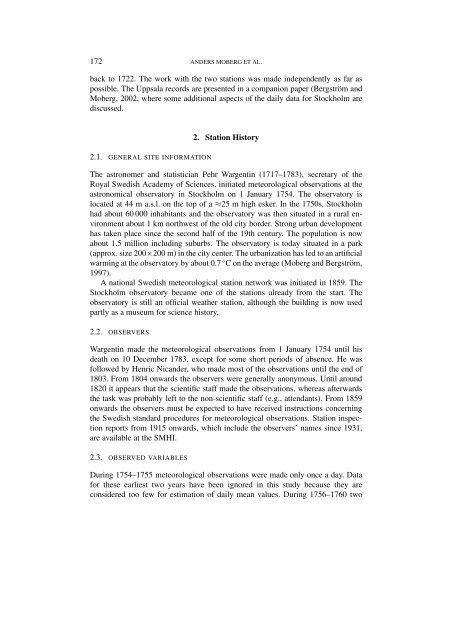DAILY AIR TEMPERATURE AND PRESSURE SERIES ... - BALTEX
DAILY AIR TEMPERATURE AND PRESSURE SERIES ... - BALTEX
DAILY AIR TEMPERATURE AND PRESSURE SERIES ... - BALTEX
You also want an ePaper? Increase the reach of your titles
YUMPU automatically turns print PDFs into web optimized ePapers that Google loves.
172 <strong>AND</strong>ERS MOBERG ET AL.<br />
back to 1722. The work with the two stations was made independently as far as<br />
possible. The Uppsala records are presented in a companion paper (Bergström and<br />
Moberg, 2002, where some additional aspects of the daily data for Stockholm are<br />
discussed.<br />
2. Station History<br />
2.1. GENERAL SITE INFORMATION<br />
The astronomer and statistician Pehr Wargentin (1717–1783), secretary of the<br />
Royal Swedish Academy of Sciences, initiated meteorological observations at the<br />
astronomical observatory in Stockholm on 1 January 1754. The observatory is<br />
located at 44 m a.s.l. on the top of a ≈25 m high esker. In the 1750s, Stockholm<br />
had about 60 000 inhabitants and the observatory was then situated in a rural environment<br />
about 1 km northwest of the old city border. Strong urban development<br />
has taken place since the second half of the 19th century. The population is now<br />
about 1.5 million including suburbs. The observatory is today situated in a park<br />
(approx. size 200×200 m) in the city center. The urbanization has led to an artificial<br />
warming at the observatory by about 0.7 ◦ C on the average (Moberg and Bergström,<br />
1997).<br />
A national Swedish meteorological station network was initiated in 1859. The<br />
Stockholm observatory became one of the stations already from the start. The<br />
observatory is still an official weather station, although the building is now used<br />
partly as a museum for science history.<br />
2.2. OBSERVERS<br />
Wargentin made the meteorological observations from 1 January 1754 until his<br />
death on 10 December 1783, except for some short periods of absence. He was<br />
followed by Henric Nicander, who made most of the observations until the end of<br />
1803. From 1804 onwards the observers were generally anonymous. Until around<br />
1820 it appears that the scientific staff made the observations, whereas afterwards<br />
the task was probably left to the non-scientific staff (e.g., attendants). From 1859<br />
onwards the observers must be expected to have received instructions concerning<br />
the Swedish standard procedures for meteorological observations. Station inspection<br />
reports from 1915 onwards, which include the observers’ names since 1931,<br />
are available at the SMHI.<br />
2.3. OBSERVED VARIABLES<br />
During 1754–1755 meteorological observations were made only once a day. Data<br />
for these earliest two years have been ignored in this study because they are<br />
considered too few for estimation of daily mean values. During 1756–1760 two













